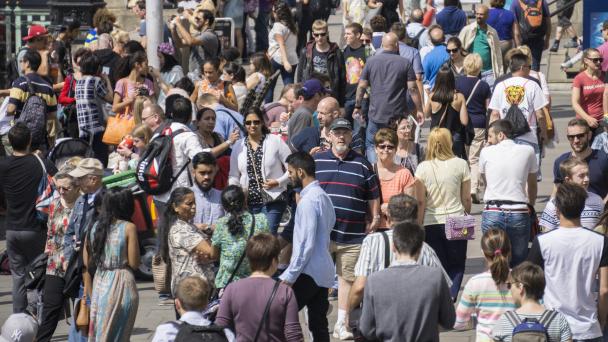Dividing lines: a classification of British voters


‘Dividing lines’, the National Centre for Social Research (NatCen)’s classification of British voters, was launched on Wednesday 5 June. Based on who voters are and what values they uphold, our research identifies the six key types of voters in Britain today and the issues that divide them. These insights are based on decades of research using our annual British Social Attitudes (BSA) survey – the longest-running measure of public opinion in Britain. They show how politics these days is multidimensional, not simply a division between 'left' and 'right'.
'Dividing lines’ has helped to inform the BBC’s Undercover Voters project. The BBC’s Disinformation and Social Media Correspondent, Marianna Spring, has created 24 Undercover Voters based in eight constituencies around the UK. She uses their social media accounts to interrogate how the election is unfolding on people’s social media feeds up and down the country. Read on to find out how we provided advice on these 24 characters.
Each of the English, Scottish and Welsh Undercover Voters are based on the opinion profile of one of the six voter types in our classification. In fact, we zoomed in further and looked at subtypes, to ensure that an even richer spread of views and opinions were present in these 21 Undercover Voters. A full description of this work will be launched on Wednesday 5 June.
We did a separate analysis of Northern Irish voters, which the three Northern Irish Undercover Voters are based on. For all four nations, we advised on each type of voter’s demographic traits, such as likely age group, gender, ethnicity, education level and financial situation.
BBC’s Undercover Voters investigation focuses in on eight constituencies. Our advice to the BBC centered on ensuring that all 24 characters combined produced a good representation of a spread of views and demographics. We also advised on which voter types would be more likely in each of the eight constituencies that the BBC selected.
For the Undercover Voters that Marianna Spring decided to place in Scotland, we advised on the characters’ most likely views on Scottish independence and national identity. Finally, we provided advice on how many of the Undercover Voters that would be of a specific age, ethnicity or gender to stay close to the demographics of the British electorate.
The advice provided covered the likelihood of views and traits, as well as likely overall distributions and locations. The BBC has taken this advice and created fictional characters. The final views they hold, their demographic traits, their back stories and what they follow on social media are all journalistic decisions made by the BBC.
The types of voters that are likely to be found in a specific constituency is not something that there is enough survey data or Census data on to know for sure. However, by relying on quality data sources we can make an informed assessment of what’s likely. We did this for the seven English, Scottish and Welsh constituencies that the BBC had selected, in three steps.
First, we looked at the socio-demographic characteristics of each of the six voter types—their age, ethnicity, income and education—and features of where they live—such as the average level of deprivation and local house prices. We then looked at the link between these characteristics and which of the six voter types somebody is likely to be, using British Social Attitudes (BSA) data linked with the latest Census data.
Second, we used the latest Census data (from 2021) for each of the BBC's selected constituencies in England and Wales. In fact, we zoomed in even further, to groups of between 400 to 1200 households. There is publicly available data on the number of people that live in each such group of households that is quite detailed. We used data on how many people live in each area, grouped by their age, gender, and education level.
We then matched this up with data about each group of households. We used data on property prices, the share of households living in poverty, the share of people that identify as White British, the ONS Census classification, and how many people had moved to the neighbourhood in the last year from within the UK and from abroad.
Third, we used two data modelling techniques to compare the characteristics of each of our six voter types with the characteristics of each of these household groups. We then added together our assessment of the local household groups to create constituency estimates. This allowed us to predict which voter groups are most likely to live in each of the constituencies.
In Scotland, the Census 2022 data wasn’t fully released when this research was concluded, so we’ve supplemented the available data with data from the 2023 Annual Population Survey. This doesn’t provide data for all of the newly created constituencies, so we assessed how the older and newer constituency boundaries compare and based our advice on the best historic match.
While we have been able to give the BBC informed advice on which voter groups are most likely to be found in Scotland overall, as well as in the two selected constituencies, the constituency advice wasn’t as robust as our advice for England and Wales. Luckily, we have robust estimates for the spread of views in Scotland overall that we could sense-check against.
As views on Scottish independence is a key dividing line in Scottish politics, we made use of the historic link between the Scottish Social Attitudes and British Social Attitudes and their partial overlap in questions asked to assess the Undercover Voters most likely views on this question and on national identity. Priority was given to ensuring that the split between the six Undercover Voters represented the split in Scotland overall in our advice.
The British Social Attitudes (BSA) survey, which we used to create the six voter types, doesn’t collect data in Northern Ireland. Instead, we’ve used the 2022 Northern Ireland Life and Times Survey (NILT). We considered different ways of grouping the data, and landed on a grouping by self-expressed national identity. We then generated estimates for each of these groups, and the likely spread of views within each.
The Northern Irish survey source covers views and attitudes on some of the UK’s main shared social and political issues, as well as Northern Ireland specific content. This means that the advice that the Northern Ireland Undercover Voters are based on doesn’t cover exactly the same issues as the Undercover Voters in the other three nations.
For Northern Ireland, we also made the decision to base the advice for the three characters on data for all of Northern Ireland, as the characters need to be representative of all of the UK. The Undercover Voter profiles that the BBC created were also sense-checked against survey data estimates for Northern Irish constituencies of a similar profile to the Northern Irish constituency the BBC had selected.
> Find out more about Dividing Lines: a classification of British voters
British Social Attitudes (BSA) 2023 – to be released soon.
Consumer Data Research Centre (2021). The 2021 Classification for Output Areas.
Accessed at: https://data.cdrc.ac.uk/dataset/output-area-classification-2021
Devine, P. (2023). Northern Ireland Life and Times Survey, 2022. [data collection]. UK Data Service.
SN: 9138, DOI: http://doi.org/10.5255/UKDA-SN-9138-1
House of Commons Library (2024) Boundary review 2023: Which seats will change in the UK?
Accessed at: https://commonslibrary.parliament.uk/boundary-review-2023-which-seats-will-change/
ONS (2021) Census population estimates nested by Age, highest level of qualification and sex on LSOA level. Accessed at: https://www.ons.gov.uk/datasets/create/filter-outputs/66f2bf92-ab61-48d5-8f70-ce7795743863#get-data
ONS (2023) Annual population survey. Accessed at: https://www.nomisweb.co.uk/
ONS (2023) Median house prices by lower layer super output area: HPSSA dataset 46. Accessed at: https://www.ons.gov.uk/peoplepopulationandcommunity/housing/datasets/medianpricepaidbylowerlayersuperoutputareahpssadataset46
Scotland's Census (2022). National Records of Scotland.
Accessed at: https://www.scotlandscensus.gov.uk/
Scottish Social Attitudes (SSA) 2023 – to be released soon.
Receive a regular update, sent directly to your inbox, with a summary of our current events, research, blogs and comment.
Subscribe